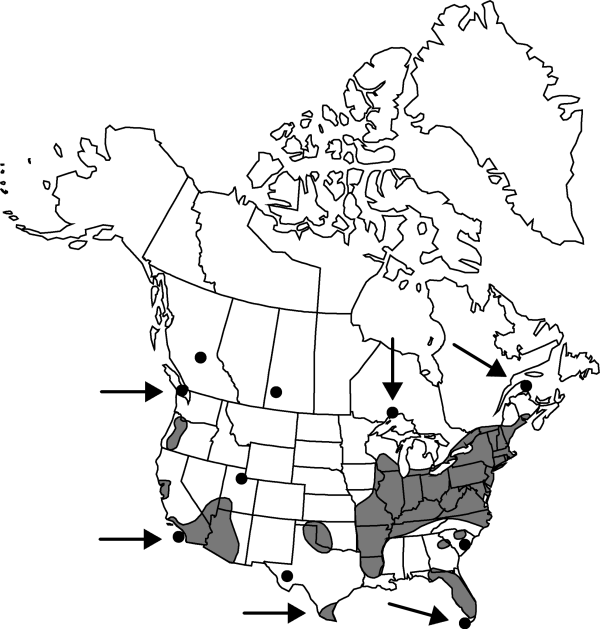Difference between revisions of "Chenopodium murale"
Sp. Pl. 1: 219. 1753.
FNA>Volume Importer |
imported>Volume Importer |
||
| (5 intermediate revisions by 2 users not shown) | |||
| Line 8: | Line 8: | ||
}} | }} | ||
|common_names=Sowbane;nettle-leaf goosefoot | |common_names=Sowbane;nettle-leaf goosefoot | ||
| + | |special_status={{Treatment/ID/Special_status | ||
| + | |code=W | ||
| + | |label=Weedy | ||
| + | }}{{Treatment/ID/Special_status | ||
| + | |code=I | ||
| + | |label=Introduced | ||
| + | }}{{Treatment/ID/Special_status | ||
| + | |code=F | ||
| + | |label=Illustrated | ||
| + | }} | ||
|basionyms= | |basionyms= | ||
|synonyms= | |synonyms= | ||
| Line 24: | Line 34: | ||
|elevation=0-2000 m | |elevation=0-2000 m | ||
|distribution=B.C.;N.B.;Ont.;Que.;Sask.;Ariz.;Ark.;Calif.;Conn.;Del.;D.C.;Fla.;Ga.;Ill.;Ind.;Ky.;La.;Maine;Md.;Mass.;Mich.;Mo.;Nev.;N.J.;N.Y.;N.C.;Ohio;Okla.;Oreg.;Pa.;R.I.;S.C.;Tenn.;Tex.;Utah;Vt.;Va.;W.Va.;Wis.;native to Europe;Asia;n Africa;introduced nearly worldwide;mostly in subtropics and warm-temperate regions. | |distribution=B.C.;N.B.;Ont.;Que.;Sask.;Ariz.;Ark.;Calif.;Conn.;Del.;D.C.;Fla.;Ga.;Ill.;Ind.;Ky.;La.;Maine;Md.;Mass.;Mich.;Mo.;Nev.;N.J.;N.Y.;N.C.;Ohio;Okla.;Oreg.;Pa.;R.I.;S.C.;Tenn.;Tex.;Utah;Vt.;Va.;W.Va.;Wis.;native to Europe;Asia;n Africa;introduced nearly worldwide;mostly in subtropics and warm-temperate regions. | ||
| + | |introduced=true | ||
|discussion=<p><i>Chenopodium murale</i> is distinctive and is one of the more common species of the genus in the world, especially in tropical and subtropical regions.</p> | |discussion=<p><i>Chenopodium murale</i> is distinctive and is one of the more common species of the genus in the world, especially in tropical and subtropical regions.</p> | ||
|tables= | |tables= | ||
| Line 33: | Line 44: | ||
-->{{#Taxon: | -->{{#Taxon: | ||
name=Chenopodium murale | name=Chenopodium murale | ||
| − | |||
|authority=Linnaeus | |authority=Linnaeus | ||
|rank=species | |rank=species | ||
| Line 48: | Line 58: | ||
|publication title=Sp. Pl. | |publication title=Sp. Pl. | ||
|publication year=1753 | |publication year=1753 | ||
| − | |special status= | + | |special status=Weedy;Introduced;Illustrated |
| − | |source xml=https:// | + | |source xml=https://bitbucket.org/aafc-mbb/fna-data-curation/src/2e0870ddd59836b60bcf96646a41e87ea5a5943a/coarse_grained_fna_xml/V4/V4_537.xml |
|genus=Chenopodium | |genus=Chenopodium | ||
|subgenus=Chenopodium subg. Chenopodium | |subgenus=Chenopodium subg. Chenopodium | ||
Latest revision as of 21:59, 5 November 2020
Stems erect, branched, 1–6(–10) dm, glabrous (to sparsely farinose when young); proximal branches decumbent. Leaves nonaromatic; petiole 1–2.5 cm; blade triangular, ovate, or rhombic-ovate, 0.8–4(–8) × 0.4–3(–5) cm, base cuneate to rounded, margins irregularly dentate, apex acute to acuminate, glabrous (rarely indistinctly farinose when young). Inflorescences glomerules in terminal and lateral panicles, 6–7 × 4–5 cm; glomerules subglobose, 2–4 mm diam., or some flowers not in glomerules; bracts absent. Flowers: perianth segments 5, distinct nearly to base; lobes ovate, 0.5–0.8 × 0.6–0.7 mm, apex acute to obtuse, keeled abaxially, farinose, covering fruit at maturity; stamens 5; stigmas 2, 0.2 mm. Achenes depressed-ovoid; pericarp adherent, pustulate, becoming smooth with maturity. Seeds lenticular, round, 1–1.5 mm diam.; seed coat black, minutely rugose to ± smooth. 2n = 18.
Phenology: Fruiting fall.
Habitat: Waste places, roadsides, clay mounds, open oak woods, prairies, rocky hillsides, along railways
Elevation: 0-2000 m
Distribution

Introduced; B.C., N.B., Ont., Que., Sask., Ariz., Ark., Calif., Conn., Del., D.C., Fla., Ga., Ill., Ind., Ky., La., Maine, Md., Mass., Mich., Mo., Nev., N.J., N.Y., N.C., Ohio, Okla., Oreg., Pa., R.I., S.C., Tenn., Tex., Utah, Vt., Va., W.Va., Wis., native to Europe, Asia, n Africa, introduced nearly worldwide, mostly in subtropics and warm-temperate regions.
Discussion
Chenopodium murale is distinctive and is one of the more common species of the genus in the world, especially in tropical and subtropical regions.
Selected References
None.
